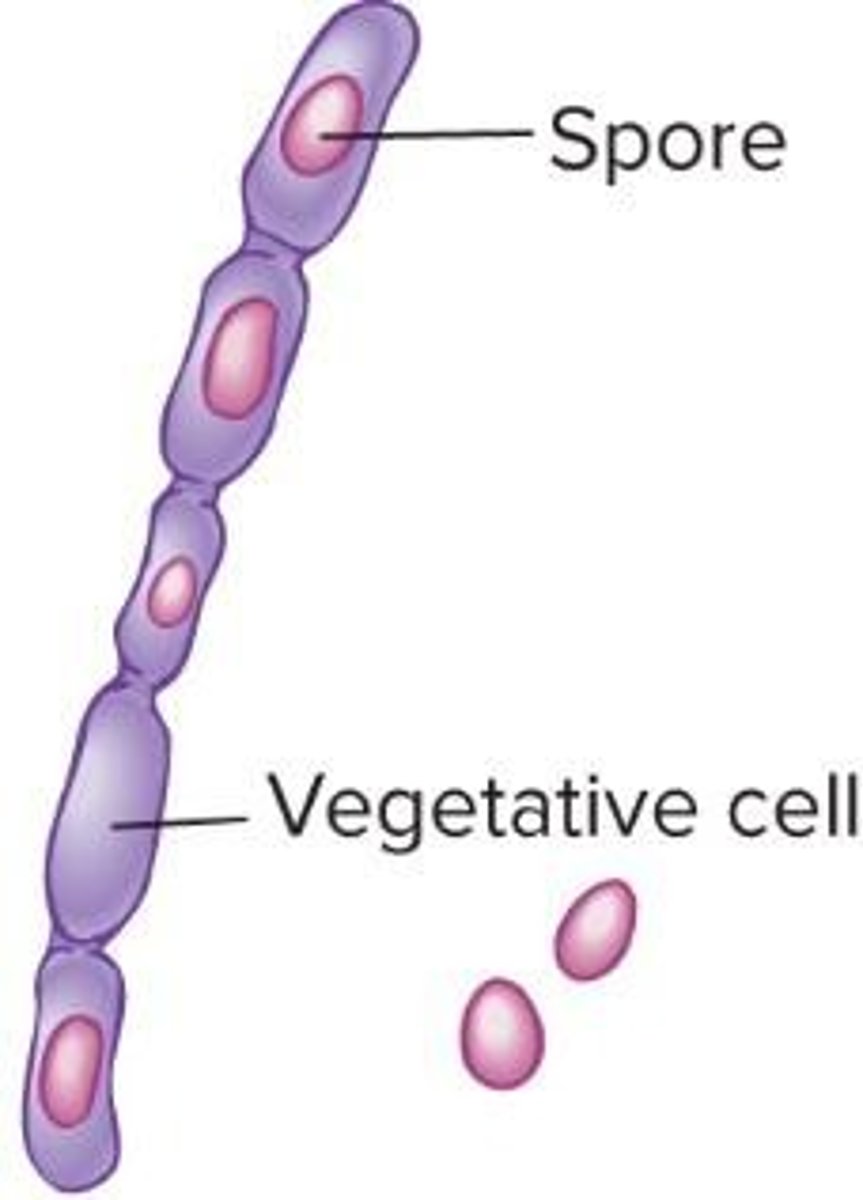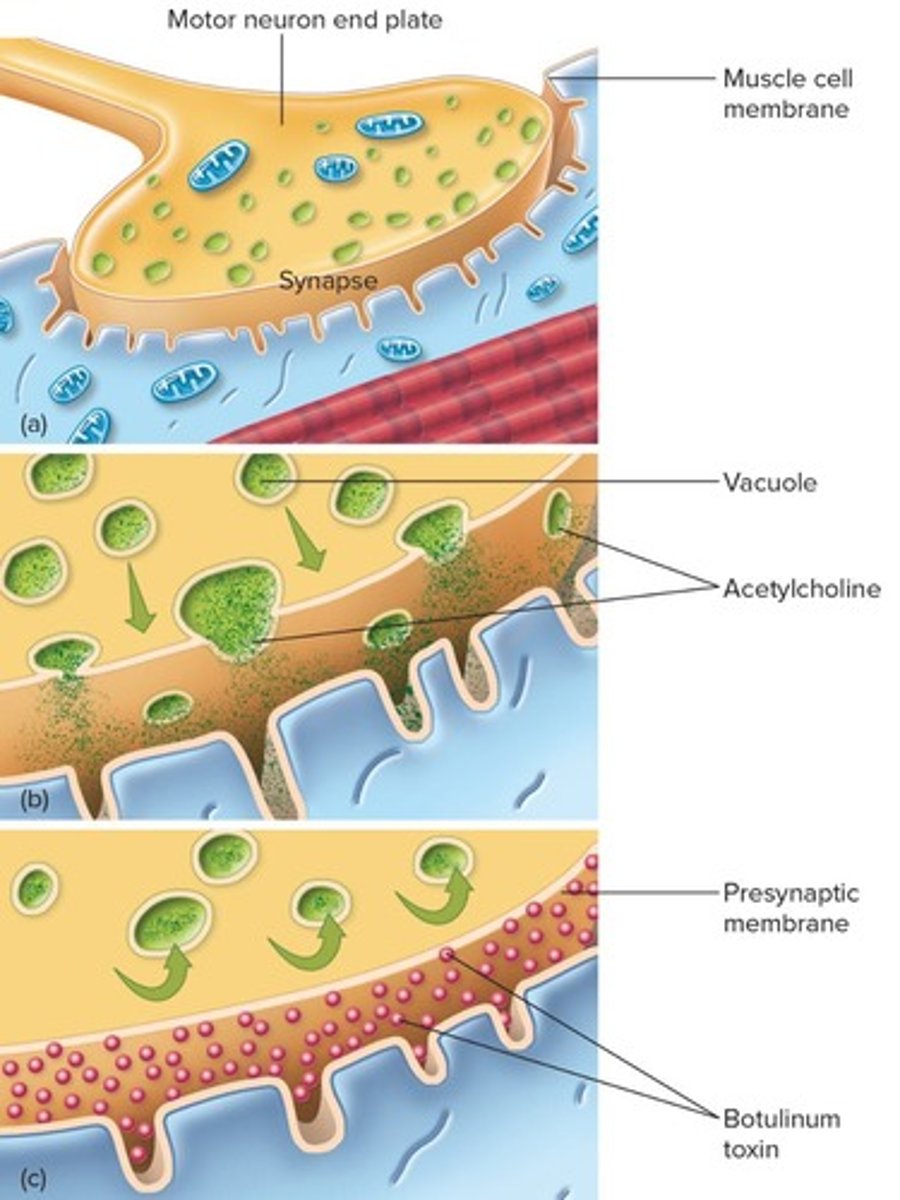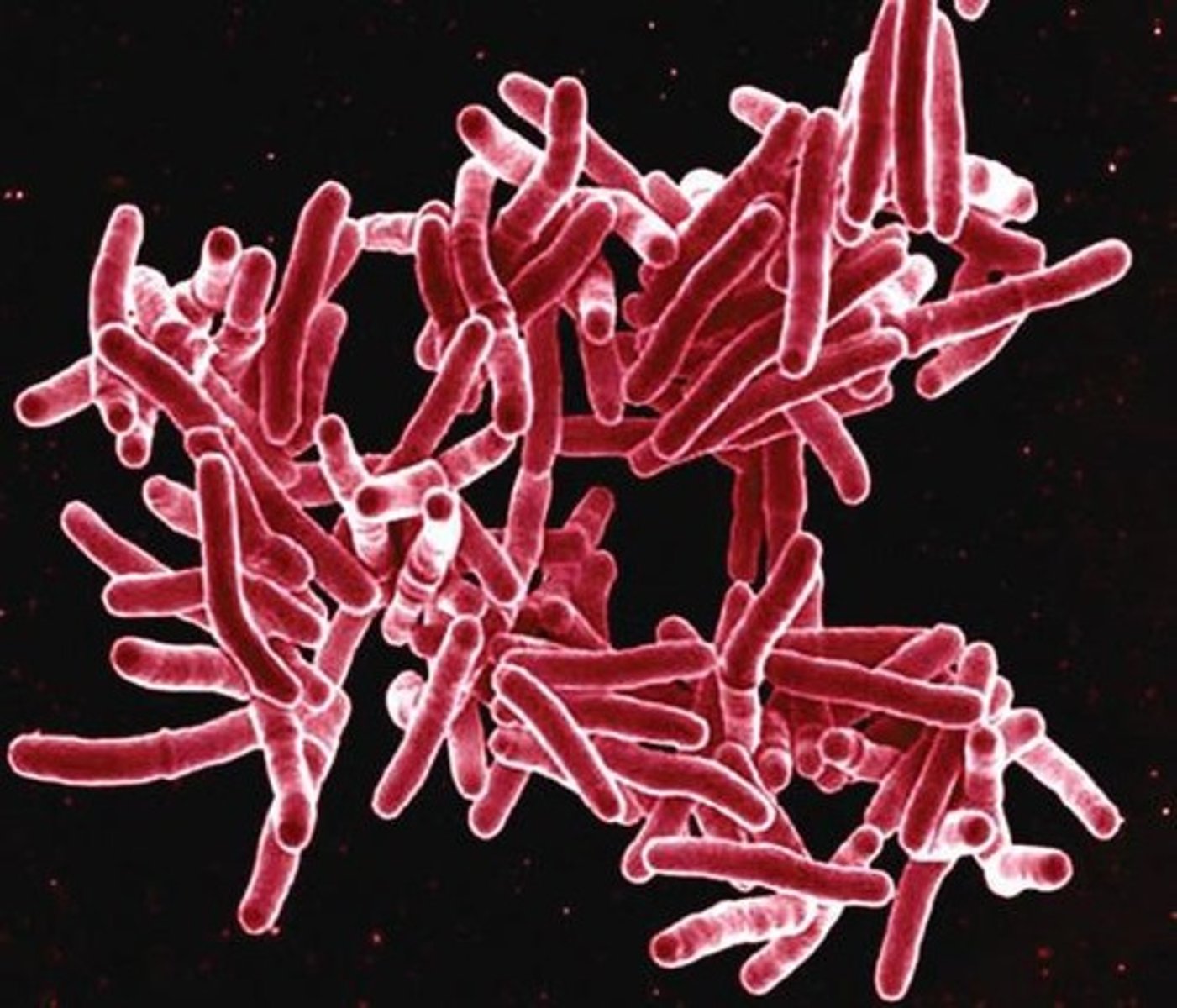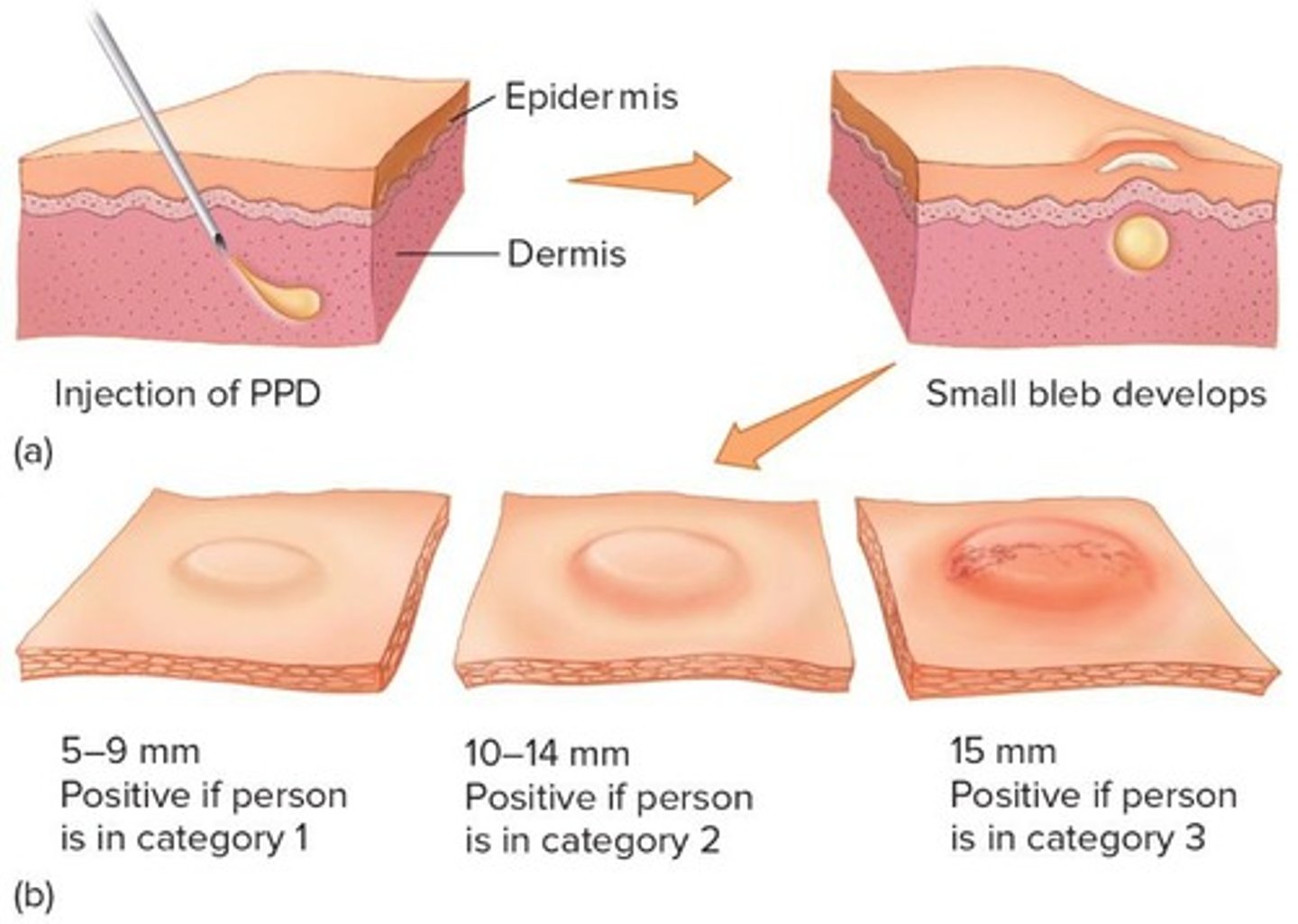Gram-Positive Bacilli of Medical Importance
1/64
There's no tags or description
Looks like no tags are added yet.
Name | Mastery | Learn | Test | Matching | Spaced |
|---|
No study sessions yet.
65 Terms
What are the three general groups of medically important Gram-positive bacilli?
Endospore-formers, Non-endospore-formers, Irregular shaped and staining properties.
What is an endospore?
A dense survival unit that develops in a vegetative cell in response to nutrient deprivation.

Which genera are most endospore-forming bacteria found in?
Bacillus and Clostridium.
What characteristics make endospore-forming bacteria resistant?
They are resistant to heat, drying, radiation, and chemicals.
What are the general characteristics of the genus Bacillus?
Gram-positive, endospore-forming, motile rods that are mostly saprobic, aerobic, and catalase positive.
What is the primary habitat of Bacillus species?
Soil.
What are the two species of Bacillus that are of medical importance?
Bacillus anthracis and Bacillus cereus.
What disease does Bacillus anthracis cause?
Anthrax.
What type of food poisoning is caused by Bacillus cereus?
One type of food poisoning.
What are the three types of anthrax?
Cutaneous, Pulmonary, and Gastrointestinal.
How does cutaneous anthrax occur?
Spores enter through the skin, causing a black sore (eschar); it is the least dangerous form.
What is the mode of transmission for pulmonary anthrax?
Inhalation of spores from animal products or soil.
How is gastrointestinal anthrax contracted?
By ingesting spores.
Where are the majority of anthrax cases reported?
In livestock from Africa, Asia, and the Middle East.
What is the significance of Bacillus species in ecology?
They are versatile in degrading complex macromolecules and are a source of antibiotics.
What is the catalase reaction of Bacillus species?
They are catalase positive.
What is the shape and motility of Bacillus species?
They are rod-shaped and motile.
What is the treatment for anthrax?
Treated with clindamycin, doxycycline, or ciprofloxacin, along with Raxibacumab, a monoclonal antibody.
What types of vaccines are available for anthrax?
Live spores and toxoid for livestock; purified toxoid (Biothrax) for high-risk occupations and military personnel, requiring 6 inoculations over 1.5 years and annual boosters.
What are the characteristics of the genus Clostridium?
Gram-positive, spore-forming rods that are anaerobic, catalase negative, and produce organic acids, alcohols, and exotoxins.
What is gas gangrene and which organism is primarily responsible for it?
Gas gangrene, or myonecrosis, is primarily caused by Clostridium perfringens.
What are common predisposing factors for gas gangrene?
Surgical incisions, compound fractures, diabetic ulcers, septic abortions, puncture wounds, and gunshot wounds.
What are the virulence factors of Clostridium perfringens?
Alpha toxin, collagenase, hyaluronidase, and DNase.
What are the two forms of gas gangrene?
Anaerobic cellulitis, which is localized, and true myonecrosis, which is more destructive.
What is the treatment for gas gangrene?
Immediate cleansing of wounds, debridement, large doses of cephalosporin or penicillin, and hyperbaric oxygen therapy.
What is tetanospasmin and its effect on the body?
Tetanospasmin is a neurotoxin that causes paralysis by blocking neurotransmitter release, leading to uncontrollable muscle contractions.
Who is most at risk for tetanus?
Geriatric patients, IV drug abusers, and neonates in developing countries.
What is Clostridium difficile infection (CDI)?
A clostridial disease that is the second most common intestinal disease after salmonellosis, often causing diarrhea in hospitals.
What are the two Clostridium species involved in food poisoning?
Clostridium botulinum, which causes severe intoxication, and Clostridium perfringens, which causes mild intestinal illness.
What is the mechanism of botulinum toxin?
It blocks the release of acetylcholine at neuromuscular junctions, causing symptoms like double vision and difficulty swallowing.

What is infant botulism?
Caused by ingested spores that germinate in the immature intestinal tract, leading to flaccid paralysis known as 'floppy baby syndrome'.
What is the primary reservoir for Listeria monocytogenes?
Soil and water, as well as animal intestines.
What are the virulence factors of Listeria monocytogenes?
Ability to replicate in the cytoplasm of cells after inducing phagocytosis.
What is the primary disease caused by Corynebacterium diphtheriae?
Diphtheria, which can cause upper respiratory tract inflammation and pseudomembrane formation.
What are the two stages of diphtheria disease?
Local infection with upper respiratory symptoms and cutaneous diphtheria with potential toxemia.
What are the characteristics of Mycobacterium tuberculosis?
Gram-positive, irregular bacilli that are acid-fast, strict aerobes, and grow slowly.

What are the clinical forms of tuberculosis?
Primary tuberculosis, secondary tuberculosis (reactivation), and disseminated (extrapulmonary) tuberculosis.
What is the Mantoux test?
A tuberculin sensitivity test involving intradermal injection of purified protein derivative (PPD) to check for induration.

What is Mycobacterium leprae and what disease does it cause?
Hansen's bacillus, which causes leprosy, a chronic disease affecting skin and nerves.
What are the two forms of leprosy?
Tuberculoid (paucibacillary) leprosy, which is less severe, and lepromatous (multibacillary) leprosy, which is more severe and disfiguring.
What is the treatment for leprosy?
Long-term combined therapy; no definitive vaccine is currently available.
What is the primary cause of disseminated mycobacterial infection in AIDS patients?
Mycobacterium avium complex bacilli.
What is the significance of non-tuberculous mycobacteria (NTM) infections?
They can cause pulmonary infections, particularly in individuals with underlying lung conditions.
What is the mode of transmission for Bacillus cereus?
Ingestion
What is the action of the botulinum toxin on?
Neuromuscular junction
What disease does Corynebacterium diphtheriae cause?
It causes a pseudomembrane and respiratory distress.
How can infection by Corynebacterium diphtheriae be prevented?
With a vaccine.
How is tuberculosis spread?
Via respiratory droplets.
Which mycobacterium is responsible for the third most common cause of death in AIDS patients?
M. avium complex.
What are the two main genera of Actinomycetes involved in human disease?
Actinomyces and Nocardia.
What is the disease caused by Actinomyces israelii?
Actinomycosis.
What pulmonary disease is caused by Nocardia brasiliensis?
Nocardiosis.
What type of bacteria is Mycobacterium?
Acid-fast bacilli.
What is the significance of lepromin in leprosy diagnosis?
It is used to detect delayed allergy to leprosy.
What are the characteristics of Gram-positive bacilli?
They can be endospore formers, aerobic or facultative anaerobes, or obligate anaerobes.
What are the non-endospore forming Gram-positive bacilli?
Listeria and Erysipelothrix.
What are the irregular shape and staining properties of non-acid-fast bacilli?
Corynebacterium and Propionibacterium.
What is the primary source of M. paratuberculosis?
Raw cow's milk.
Which mycobacterium infects cervical lymph nodes in children?
M. scrofulaceum.
What is the common name for the lesions caused by M. marinum?
Fish tank granuloma.
What type of infection can Actinomycetes cause?
Chronic infection of skin and soft tissues.
What is the primary characteristic of filamentous bacilli?
They are nonmotile filamentous rods.
What is the primary mode of transmission for tuberculosis?
Respiratory droplets.
What is the clinical form of leprosy that can be detected by lepromin?
Delayed allergy response.
What is the significance of the Gram-positive bacilli identification flowchart?
It helps differentiate between various Gram-positive bacilli based on their characteristics.